Fig
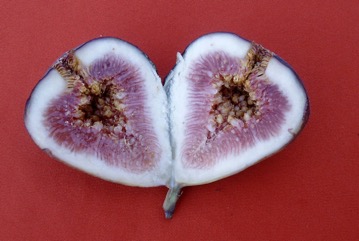
It suits tropical, subtropical and warm temperate regions. It is native to S.W. Asia. It can stand light frosts once hardened. Of the very large number of figs in PNG, this one is introduced. It suits highland areas in the tropics with a lower rainfall. It produces better if rain is less at flowering. Good summer heat is necessary for sugar-rich fruit. Plants do best in heavy soil in well prepared sites. It needs a neutral pH. It has some salt tolerance. In Brisbane Botanical Gardens. In Nepal it grows to about 1200 m altitude. In some places it can grow up to 2,300 m above sea level. It suits hardiness zones 10-12. In Sichuan. In Yunnan.
Also known as:
Adriatic fig, Anjeer, Anjir, Anjira, Anjura, Anjuru, Aviavimbazaha, Baghi inzar, Black Mission fig, Brown Turkey fig, Buah tin, Calimyrna fig, Dumur, Fico, Figo-roxo, Figo, Figueira, Fique, Flowerless fruit, Goolar, Hejir, Higo, Higuera comun, Higuera, Ichijiku, Incir, Inzar, Inzer, Leghvi, Manjimedi, Mati, Muhwagwanamu, Paka, Phagwar, Phogwara, Sico, Simaiyatti, Simayatti, Sitube pakar, Smokinya, Smyrna fig, Te biku, Teen, Tenatti, Thinbaw-thapan, Tin, Wu hua guo, Yabani incir, Yemis
Synonyms
- Ficus kopetdagensis Pachom.
- and many others
Edible Portion
- Fruit, Flowers, Leaves - flavouring
Where does Fig grow?
Found in: Afghanistan, Africa, Albania, Algeria, Armenia, Australia, Azerbaijan, Bahrain, Bangladesh, Brazil, Britain, Bulgaria, Burkina Faso, Canada, Caucasus, Central America, Central Asia, China, Cook Islands, Costa Rica, Crete, Cuba, Cyprus, Dominican Republic, East Africa, Easter Island, Ecuador, Egypt, Ethiopia, Europe, Fiji, France, Georgia, Germany, Gibraltar, Greece, Guam, Haiti, Hawaii, Himalayas, India, Indochina, Indonesia, Iran, Iraq, Israel, Italy, Jamaica, Jordan, Kiribati, Korea, Lebanon, Macedonia, Madagascar, Malawi, Malta, Mauritania, Mediterranean, Mexico, Micronesia, Montenegro, Morocco, Myanmar, Nepal, New Zealand, Niger, North Africa, North America, Northeastern India, Pacific, Pakistan, Palau, Palestine, Papua New Guinea, PNG, Philippines, Portugal, Puerto Rico, Qatar, Russia, Sao Tome and Principe, Saudi Arabia, SE Asia, Serbia, Sinai, Slovenia, South Africa, Southern Africa, South America, Spain, St Helena, Syria, Tajikistan, Tasmania, Thailand, Tonga, Tunisia, Turkey, Turkmenistan, Tuvalu, United Arab Emirates, UAE, Uruguay, United States, Uzbekistan, West Africa, West Indies, Zimbabwe
Notes: There are about 800-1000 Ficus species. They are mostly in the tropics. There are 120 Ficus species in tropical America. It has anticancer properties.
Status: They have been introduced to Papua New Guinea, and tried but are not common.
Growing Fig
Cultivation: Plants can be grown by seeds. It can be grown by stem cuttings. It can also be grown by budding and grafting. Smyrna figs need fig wasps for pollination. This is done by hanging male flowers near female flowers to attract the wasps. Adriatic figs develop fruit without pollination. Trees should be pruned for good production and easy harvesting.
Edible Uses: Fruit are eaten raw or cooked. They can be dried, preserved or used in jam. They are used in syrups, bread, pastries, and pies. The fruit are made into brandy and wine. Food is wrapped in the leaves while cooking to impart flavour. This is used with fish. The latex is used to coagulate milk for cheese and junket.
Production: Figs start to bear after about 5-7 years and can continue for decades but they become unprofitable after 50 years. Fruit ripen in their second year. Normally figs have 2 harvests per year. The first crop is from old wood and the second from newer wood.
Nutrition Info
per 100g edible portion| Edible Part | Energy (kcal) | Protein (g) | Iron (mg) | Vitamin A (ug) | Vitamin c (mg) | Zinc (mg) | % Water |
|---|---|---|---|---|---|---|---|
| Fruit green raw | 42 | 1.3 | 0.4 | 500 | 2 | 0.3 | 84.6 |
| Fruit dried raw | 217 | 3.6 | 4.2 | 50 | 0 | 0.9 | 16.8 |
| Fruit dried stewed | 121 | 2 | 2.3 | 30 | 0 | 0.5 | 50.7 |
Fig Photos

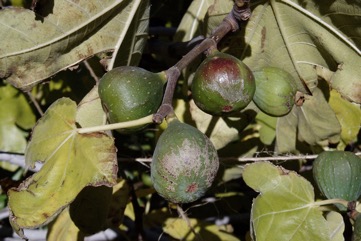
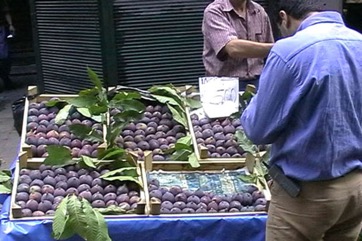
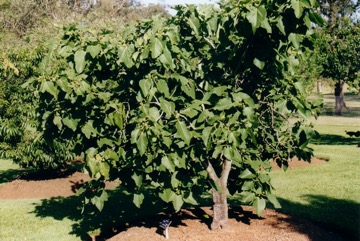
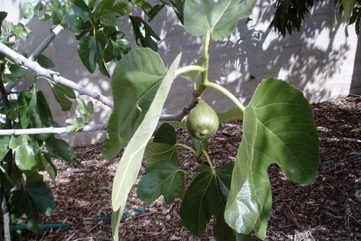
References
Abbasi, A. M., Khan, M & Zafar, M., 2013, Ethno-medicinal assessment of some selected wild edible fruits and vegetables of Lesser-Himalayas, Pakistan. Pak. J. Bot. 45 (SI):215-222
Achtak, H., et al, 2010, Traditional agroecosystems as conservatories and incubators of cultivated plant varietal diversity: the case of fig (Ficus carica L.) in Morocco. BMC Plant Biology, 10:28
Ahmad, S. A. & Askari, A. A., 2015, Ethnobotany of the Hawraman Region of Kurdistan Iraq. Harvard Papers in Botany, Vol. 20, No. 1, 2015, pp. 85–89
Ambasta, S.P. (Ed.), 2000, The Useful Plants of India. CSIR India. p 221
Anderson, E. F., 1993, Plants and people of the Golden Triangle. Dioscorides Press. p 211
Arora, R. K., 2014, Diversity in Underutilized Plant Species - An Asia-Pacific Perspective. Bioversity International. p 71
Awan, M. R., et al, 2011, Studies on traditional knowledge of economically important plants of Kaghan Valley, Mansehra District, Pakistan. Journal of Medicinal Plants Research Vol. 5(16), pp. 3958-3967
Bajpai, O., et al, 2015, Tree species of the Himalayan Terai region of Uttar Pradesh, India: a checklist. Check List 11(4): 1718
Barkatullah, et al, 2009, Ethnobotanical studies of plants of Charkotli Hills, Batkhela District, Malakand, Pakistan. Front. Biol. China 2009, 4(4): 539–548
Barkatullah and Ibrar, M., 2011, Plants profile of Malakand Pass Hills, District Malakand, Pakistan. African Journal of Biotechnology Vol. 10 (73) pp. 16521-16535
Blamey, M and Grey-Wilson, C., 2005, Wild flowers of the Mediterranean. A & C Black London. p 34
Bekele-Tesemma A., Birnie, A., & Tengnas, B., 1993, Useful Trees and Shrubs for Ethiopia. Regional Soil Conservation Unit. Technical Handbook No 5. p 244
Bernholt, H. et al, 2009, Plant species richness and diversity in urban and peri-urban gardens of Niamey, Niger. Agroforestry Systems 77:159-179
Bodkin, F., 1991, Encyclopedia Botanica. Cornstalk publishing, p 472
Bonet, M. A. & Valles, J., 2002, Use of non-crop food vascular plants in Montseny biosphere reserve (Catalonia, Iberian Peninsula). International Journal of Food Sciences and Nutrition (2002) 53, 225–248
Bremness, L., 1994, Herbs. Collins Eyewitness Handbooks. Harper Collins. p 57
Brickell, C. (Ed.), 1999, The Royal Horticultural Society A-Z Encyclopedia of Garden Plants. Convent Garden Books. p 438
Brouk, B., 1975, Plants Consumed by Man. Academic Press, London. p 173
Brown, D., 2002, The Royal Horticultural Society encyclopedia of Herbs and their uses. DK Books. p 213
Burkill, H. M., 1985, The useful plants of west tropical Africa, Vol. 4. Kew.
Burkill, I.H., 1966, A Dictionary of the Economic Products of the Malay Peninsula. Ministry of Agriculture and Cooperatives, Kuala Lumpur, Malaysia. Vol 1 (A-H) p 1022
Bussman, R. W., et al, 2016, A comparative ethnobotany of Khevsureti, Samtskhe-Javakheti, Tusheti, Svaneti, and Racha-Lechkhumi, Republic of Georgia (Sakartvelo), Caucasus. Journal of Ethnobiology and Ethnomedicine (2016) 12:4
Bussman, R. W. et al, 2017, Ethnobotany of Samtskhe-Javakheti, Sakartvelo (Republic of Georgia), Caucasus. Indian Journal of Traditional Knowledge Vol. 16(1) pp 7-24
Chakraborty, S. & Chaturbedi, H. P., 2014, Some Wild Edible Fruits of Tripura- A Survey. Indian Journal of Applied research. (4) 9
Chandrashekara, U. M., 2009, Tree species yielding edible fruit in the coffee-based homegardens of Kerala, India: their diversity, uses and management. Food Sec. 1:361-370
Cheifetz, A., (ed), 1999, 500 popular vegetables, herbs, fruits and nuts for Australian Gardeners. Random House p 193
Ciftcioglu, C. G., 2015, Sustainable wild-collection of medicinal and edible plants in Lefke region of North Cyprus. Agroforest Syst. Springer
Coombes, A.J., 2000, Trees. Dorling Kindersley Handbooks. p 219
Coronel, R.E., 1982, Fruit Collections in the Philippines. IBPGR Newsletter p 10
Cruz, I. M., et al, 2015, Edible fruits and seeds in the State of Mexico. Revista Mexicana de Ciencias Agricolas. Vol. 6. Num. 2 pp 331-346
Cull, B.W., 1995, Fruit Growing in Warm Climates. Reed. p 159
Cundall, P., (ed.), 2004, Gardening Australia: flora: the gardener's bible. ABC Books. p 602
Della, A., et al, 2006, An ethnobotanical survey of wild edible plants of Paphos and Larnaca countryside of Cyprus. J. Ethnobiol. Ethnomed. 2:34
Ertug, F., 2004, Wild Edible Plants of the Bodrum Area. (Mugla, Turkey). Turk. J. Bot. 28 (2004): 161-174
Ertug, F, Yenen Bitkiler. Resimli Türkiye Florası -I- Flora of Turkey - Ethnobotany supplement
Etherington, K., & Imwold, D., (Eds), 2001, Botanica's Trees & Shrubs. The illustrated A-Z of over 8500 trees and shrubs. Random House, Australia. p 326
Facciola, S., 1998, Cornucopia 2: a Source Book of Edible Plants. Kampong Publications, p 155
Farooq, S., et al, 2012, Ethnobotanical Studies of the Flora of Tehsil Birmal in South Waziristan Agency, Pakistan. Pak. J. Weed Sci. Res. 18(3): 277-291
Flora of China.
Flora of Pakistan. www.eFloras.org
Flowerdew, B., 2000, Complete Fruit Book. Kyle Cathie Ltd., London. p 54
French, B.R., 1986, Food Plants of Papua New Guinea, A Compendium. Asia Pacific Science Foundation p 287
Gunes, S. et al, 2018, Survey of wild food plants for human consumption in Karaisali (Adana-Turkey). Indian Journal of Traditional Knowledge. Vol. 17(2), April 2018, pp 290-298
Gurdal, B. & Kultur, S., 2014, The edible and miscellaneous useful plants in Marmaris (Southwest Turkey). İstanbul Ecz. Fak. Derg. / J. Fac. Pharm. Istanbul 44(1) 2014 pp.69-78
Hadjichambis, A. C., et al, 2007, Wild and semi-domesticated food plant consumption in seven circum-Mediterranean areas. International Journal of Food Sciences and Nutrition. 2007, 1-32.
Harris, E & J., 1983, Field Guide to the Trees and Shrubs of Britain. Reader's Digest. p 140
Hedrick, U.P., 1919, (Ed.), Sturtevant's edible plants of the world. p 308
Heywood, V.H., Brummitt, R.K., Culham, A., and Seberg, O. 2007, Flowering Plant Families of the World. Royal Botanical Gardens, Kew. p 218
Hussey, B.M.J., Keighery, G.J., Cousens, R.D., Dodd, J., Lloyd, S.G., 1997, Western Weeds. A guide to the weeds of Western Australia. Plant Protection Society of Western Australia. p 182
Hu, Shiu-ying, 2005, Food Plants of China. The Chinese University Press. p 358
INFOODS:FAO/INFOODS Databases
Jardin, C., 1970, List of Foods Used In Africa, FAO Nutrition Information Document Series No 2.p 136
John, L., & Stevenson, V., 1979, The Complete Book of Fruit. Angus & Robertson p 132
Kapelle, M., et al, 2000, Useful plants within a Campesino Community in a Costa Rican Montane Cloud Forest. Mountain Research and Development, 20(2): 162-171
Kayabasi, N. P., et al, 2018, Wild edible plants and their traditional use in the human nutrition in Manyas (Turkey). Indian Journal of Traditional Knowledge. Vol. 17(2), April 2018, pp 299-306
Khan, D. & Shaukat, S.S., 2006, The Fruits of Pakistan: Diversity, Distribution, Trends of Production and Use. Int. J. Biol. Biotech., 3(3):463-499
Khan, W., et al, Ethnomedicinal plants of Kakul Hills, District Abbottabad, KPK, Pakistan.
Kintzios, S. E., 2006, Terrestrial Plant-Derived Anticancer Agents and Plant Species Used in Anticancer research. Critical Reviews in Plant Sciences. 25: pp 79-113
Kiple, K.F. & Ornelas, K.C., (eds), 2000, The Cambridge World History of Food. CUP p 1774
Kizilarslan, C. & Ozhatay, N., 2012, An ethnobotanical study of the useful and edible plants of İzmit. Marmara Pharmaceutical Journal 16: 134-140, 2012.
Lazarides, M. & Hince, B., 1993, Handbook of Economic Plants of Australia, CSIRO. p 114
Liu, Yi-tao, & Long, Chun-Lin, 2002, Studies on Edible Flowers Consumed by Ethnic Groups in Yunnan. Acta Botanica Yunnanica. 24(1):41-56
Llamas, K.A., 2003, Tropical Flowering Plants. Timber Press. p 278
Lorenzi, H., Bacher, L., Lacerda, M. & Sartori, S., 2006, Brazilian Fruits & Cultivated Exotics. Sao Paulo, Instituto Plantarum de Estuados da Flora Ltda. p 439
Lyle, S., 2006, Discovering fruit and nuts. Land Links. p 204
Macmillan, H.F. (Revised Barlow, H.S., et al) 1991, Tropical Planting and Gardening. Sixth edition. Malayan Nature Society. Kuala Lumpur. p 315
Martin, F. W., et al, 1987, Perennial Edible Fruits of the Tropics. USDA Handbook 642 p 37
Miguel, E., et al, 1989, A checklist of the cultivated plants of Cuba. Kulturpflanze 37. 1989, 211-357
Morley, B.D., & Toelken, H.R., (Eds), 1983, Flowering Plants in Australia. Rigby. p 63
Morton, J. F., 1987, Fruits of Warm Climates. Wipf & Stock Publishers p 47
Nebel, S., Pieroni, A. & Heinrich, M., 2006, Ta cho`rta: Wild edible greens used in the Graecanic area in Calabria, Southern Italy. Appetite 47 (2006) 333–342
Nedelcheva A., 2013, An ethnobotanical study of wild edible plants in Bulgaria. EurAsian Journal of BioSciences 7, 77-94
Norrington, L., & Campbell, C., 2001, Tropical Food Gardens. Bloomings Books. p 101
Özdemir, E. and Kültür, S., 2017, Wild Edible Plants of Savaştepe District (Balıkesir, Turkey), Marmara Pharm J 21/3: 578-589
Paczkowska, G . & Chapman, A.R., 2000, The Western Australian Flora. A Descriptive Calatogue. Western Australian Herbarium. p 331
Pieroni, A., 1999, Gathered wild food plants in the Upper Valley of the Serchio River (Garfagnana), Central Italy. Economic Botany 53(3) pp 327-341
Pieroni, A., et al, 2005, Food for two seasons: Culinary uses of non-cultivated local vegetables and mushrooms in a south Italian village. International Journal of Food Sciences and Nutrition, 56(4): 245-272
Pieroni, A., 2008, Local plant resources in the ethnobotany of Theth, a village in the Northern Albanian Alps. Genet Resour Crop Evol (2008) 55:1197–1214
Plants for a Future database, The Field, Penpol, Lostwithiel, Cornwall, PL22 0NG, UK. http://www.scs.leeds.ac.uk/pfaf/
Plants of Haiti Smithsonian Institute http://botany.si.edu/antilles/West Indies
Polat, R., et al, 2015, Survey of wild food plants for human consumption in Elazig (Turkey). Indian Journal of Traditional Knowledge. Vol. 1(1): 69-75
Polat, R., et al, 2017, Survey of wild food plants for human consumption in Bingol, (Turkey). Indian Journal of Traditional Knowledge. Vol. 16(3) July 2017, pp. 378-384
Postman, J. D., et al, 2012, Recent NPGS Coordinated Expeditions in the Trans-Caucasus Region to Collect Wild Relatives of Temperate Fruit and Nut Crops. In Acta Horticulturae Number 948 p 191-198
Purseglove, J.W., 1968, Tropical Crops Dicotyledons, Longmans. p 388
Ruiters-Welcome, A. K., 2019, Food plants of southern Africa. Ph.D. thesis. Univ. of Johannesburg p 79
Sansanelli, S., et al, 2014, Wild food plants traditionall consumed in the area of Bologna (Emilia Romagna region, Italy). Journal of Ethnobiology and Ethnomedicine 10:69
Segura, S., et al, 2018, The edible fruit species in Mexico. Genet Resour Crop Evol (2018) 65:1767–1793
Sharma, B.B., 2005, Growing fruits and vegetables. Publications Division. Ministry of Information and broadcasting. India. p 60
Sher, H. et al, 2011, Ethnobotanical and Economic Observations of Some Plant Resources from the Northern Parts of Pakistan. Ethnobotany research & Applications 9:027-041
Sher, Z., Hussain, F., & Ibrar, M., 2014, Traditional knowledge on plant resources of Ashezai and Salarzai Valleys, District Buner, Pakistan. African Journal of Plant Science. Vol. 8(1), pp. 42-53, January 2014
Sinclair, V., 1992, The Floral Charm of Cyprus. Interworld Publications. p 156
Small, E., 2009, Top 100 Food Plants. The world's most important culinary crops. NRC Research Press. p 259
Smith, A.C., 1981, Flora Vitiensis Nova, Lawaii, Kuai, Hawaii, Volume 2 p 179
Smith, K., 1998. Growing Uncommon Fruits and Vegetables. New Holland. p 136
Song, M., et al, 2013, Traditional knowledge of wild edible plants in Jeju Island, Korea. Indian Journal of Traditional Knowledge. 12(2) pp 177-194
Sp. pl. 2:1059. 1753
Staples, G.W. and Herbst, D.R., 2005, A tropical Garden Flora. Bishop Museum Press, Honolulu, Hawaii. p 409
Storey, W.B., 1979, Fig, in Simmonds, N.W., (ed), Crop Plant Evolution. Longmans. London. p 205
Sukarya, D. G., (Ed.) 2013, 3,500 Plant Species of the Botanic Gardens of Indonesia. LIPI p 630
Swaminathan, M.S., and Kochnar, S.L., 2007, An Atlas of major Flowering Trees in India. Macmillan. p 260
Thaman, R.R., 1976, The Tongan Agricultural System, University of the South Pacific, Suva, Fiji. p 399
Thaman, R. R., 1987, Plants of Kiribati: A listing and analysis of vernacular names. Atoll Research Bulletin No. 296
Thaman, R. R, 2016, The flora of Tuvalu. Atoll Research Bulletin No. 611. Smithsonian Institute p 101
Toppo, P. et al, 2016, Wild edible plants of Dhamtari district of Chhattisgarh, India. Van Sangyan Vol. 3, No. 4
USDA, ARS, National Genetic Resources Program. Germplasm Resources Information Network - (GRIN). [Online Database] National Germplasm Resources Laboratory, Beltsville, Maryland. Available: www.ars-grin.gov/cgi-bin/npgs/html/econ.pl (10 April 2000)
Valder, P., 1999, The Garden Plants of China. Florilegium. p 285
van Wyk, Be., & Gericke, N., 2007, People's plants. A Guide to Useful Plants of Southern Africa. Briza. p 42
Wang, J. et al, 2013, A Study on the Utilization of Wild Plants for Food in Liangshan Yi Autonomous Prefecture. Plant Diversity and Resources. 35(4): 416-471
Wild Edible Plants in Lebanon. Promoting dietary diversity in poor communities in Lebanon. http://www.wildedibleplants.org/
World Checklist of Useful Plant Species 2020. Royal Botanic Gardens, Kew
Young, J., (Ed.), 2001, Botanica's Pocket Trees and Shrubs. Random House. p 384
Yesil, Y., et al, 2019, Wild edible plants in Yeşilli (Mardin-Turkey), a multicultural area. Journal of Ethnobiology and Ethnomedicine (2019) 15:52
Zizka, G., 1991, Flowering Plants of Easter Island. Palmarum Hortus Francofurtensis